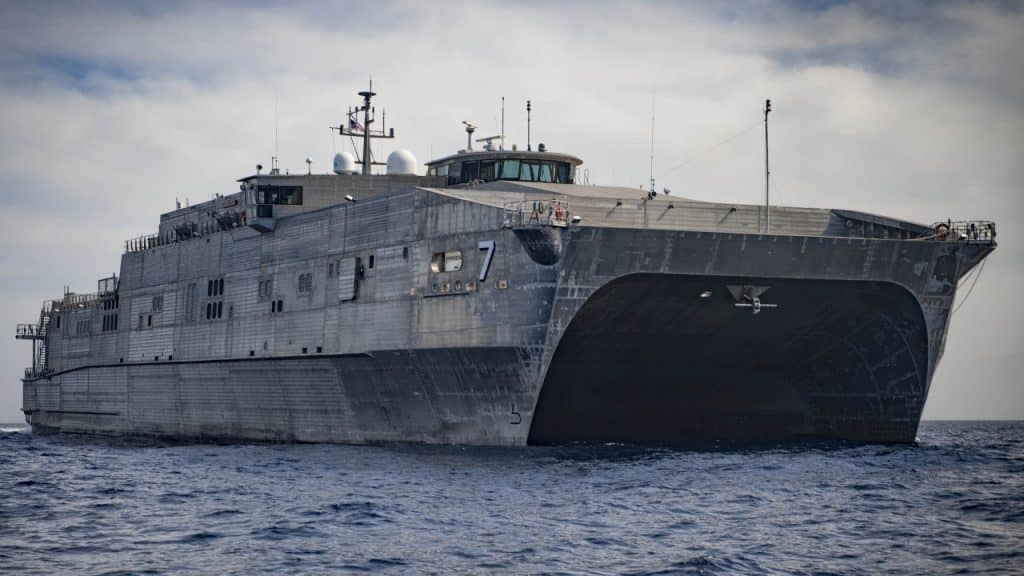On July 29, the US Navy announced that the USNS Apalachicola (T-EPF 13) logistic vessel, adapted to operate in an autonomous mode, began sea trials. According to the announcement, the planned tests are to allow the assessment of the ship’s autonomous operation capability and demonstrate that such a large unit (the ship is 103 meters long) can become an unmanned platform. The Apalachicola is the thirteenth Spearhead vessel (USNS Carson City in the title photo).
“The autonomous capabilities demonstrated by this prototype demonstrate great technical advancement for EPF, the US Navy and our industrial partners,” said Tim Roberts, Program Manager Strategic and Theater Sealift. – The EPF 13 will be the first American ship to be fully operational with autonomous capabilities and the ability to operate in commercial maritime traffic.
According to the announcement, further tests of Apalachicola are to be more demanding – they will include navigation at night and operation in various weather and sea conditions. In addition, on the basis of the trials, procedures for encountering and avoiding ships and compliance with the international regulations on preventing collisions at sea are to be developed.
-ADVERTISEMENT-

The Spearhead series are shallow draft catamarans. They were built on the basis of commercial civil ferries used by Hawaii Superferry at Austal USA, also known for the LCS Independence-class ships. EPFs have high speed – the average speed is to be 35 knots – which allows for the fast transport of 600 tons of equipment and 312 passengers, and the possibility of autonomous unloading and loading makes the ships independent of the coastal infrastructure. The units have a range of 1,200 nautical miles. EPF 13 is to be handed over to the US Navy later this year.
Unmanned units in navies
In recent years, we can observe the rapid development and growing importance of unmanned platforms. The main branch of development is the air domain, in which UAVs are often an integral part of the operation, completing reconnaissance or impact missions. Also in the land domain, we can more and more often come across completely unmanned or optionally manned vehicles. The novelty of this year is the unmanned M113 with APKWS missile launchers from BAE Systems. Also in the maritime domain, we can observe a huge increase in the role of unmanned platforms. The marine domain is specific in that its area covers everything on the water, under water and in the air.
However, a lot of novelties appear in the field of unmanned ships. One of the most recently developed branches of the navy, in which drones and autonomous vehicles are used, are mine action and hydrography. In the case of hydrography, the use of autonomous vehicles allows you to perform most of the hydrographic works with the involvement of a much cheaper unit than cutters or hydrographic ships. Since last year, the US Navy Hydrographic Office has been operating the iXblue DriX autonomous surface vehicle, intended for hydrographic measurements. Interestingly, the unit has an autonomy of up to ten days, which introduces a new quality.
Unmanned or autonomous underwater vehicles are an inseparable element of anti-mine combat. A very good example of the current trend can be the Belgian-Dutch minehunters, which, in a sense, constitute a base ship for naval drones.
The significant development of offshore autonomous platforms is not limited to smaller vessels, as demonstrated by the Apalachicola. Large ships are also built. For several years now, the US Navy has been testing large, armed autonomous ships. An example of such a unit is the USV Ranger, which in September last year conducted test firing with the use of SM-6 anti-aircraft missiles.
See the game-changing, cross-domain, cross-service concepts the Strategic Capabilities Office and @USNavy are rapidly developing: an SM-6 launched from a modular launcher off of USV Ranger. Such innovation drives the future of joint capabilities. #DoDInnovates pic.twitter.com/yCG57lFcNW
– Department of Defense 🇺🇸 (@DeptofDefense) September 3, 2021
The Autonomous Ranger was created as a result of work on the Ghost Fleet Overlord program. Its aim was to develop units that would carry out their tasks covertly, without crews and would be remotely controlled from a long distance. Autonomous ships are to take over the dangerous and time-consuming tasks that were previously performed by manned vessels. In addition, the US Navy created a separate squadron for unmanned ships: the First Unmanned Surface Vessel Division One.
It is also worth emphasizing that the work on units of this type is already so advanced that four prototypes developed as part of the “Ghost Fleet” participated in this year’s edition of RIMPAC 2022 maneuvers. These were two large monohull unmanned aerial vehicles – the Nomad and the Ranger described above – and two Sea Hunter and Seahawk medium trimarans. Unmanned ships during RIMPAC performed a wide spectrum of tasks, from cargo transportation to intelligence tasks. As Admiral Casey Moton, director of the unmanned ships program, said, the USV during RIMPAC maneuvers proved that they are reliable and mature structures with high capabilities.
So we are witnessing a revolution in the field of the development of naval fleets, and more precisely, of unmanned ships. Their development is not limited to smaller drones and autonomous units that require the support of a “mother ship”, as in the case of the Belgian-Dutch mine destroyers, but also includes large fully autonomous ships – unarmed such as the EPF 13 (as standard, only rifles are mounted on Spearheads self-defense machines), but also carrying weapons. The coming years will surely bring many news from the world of autonomous ships.
See also: Ethiopia: The scale of the crime in Tigray has been revealed
US Navy / Mass Communication Specialist 3rd Class Ford Williams

